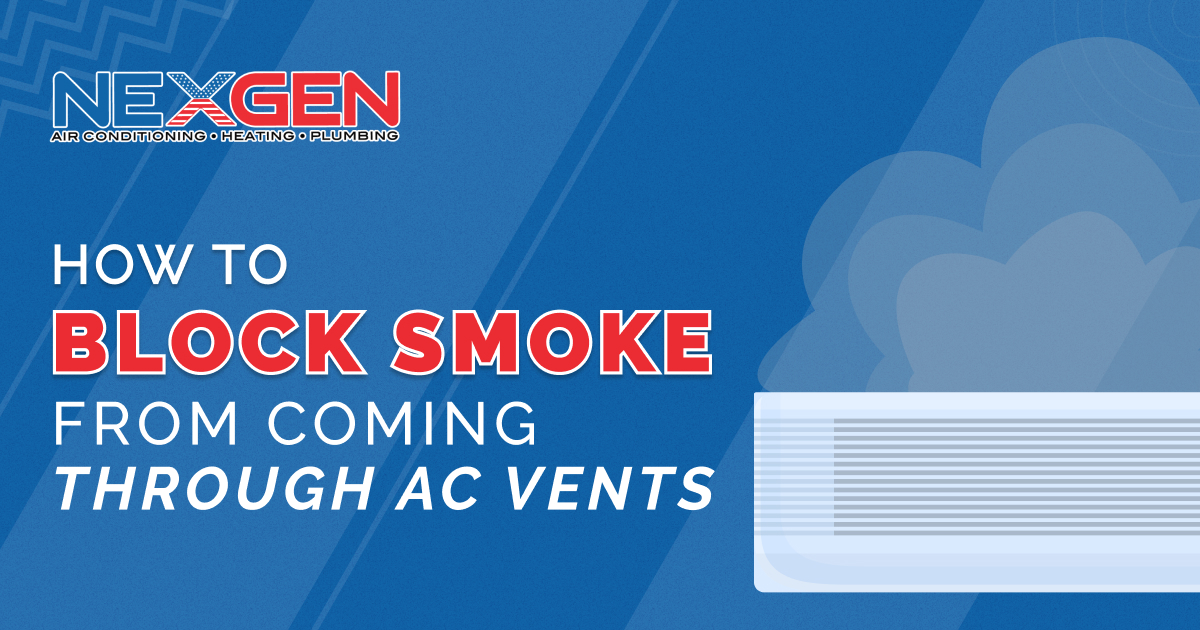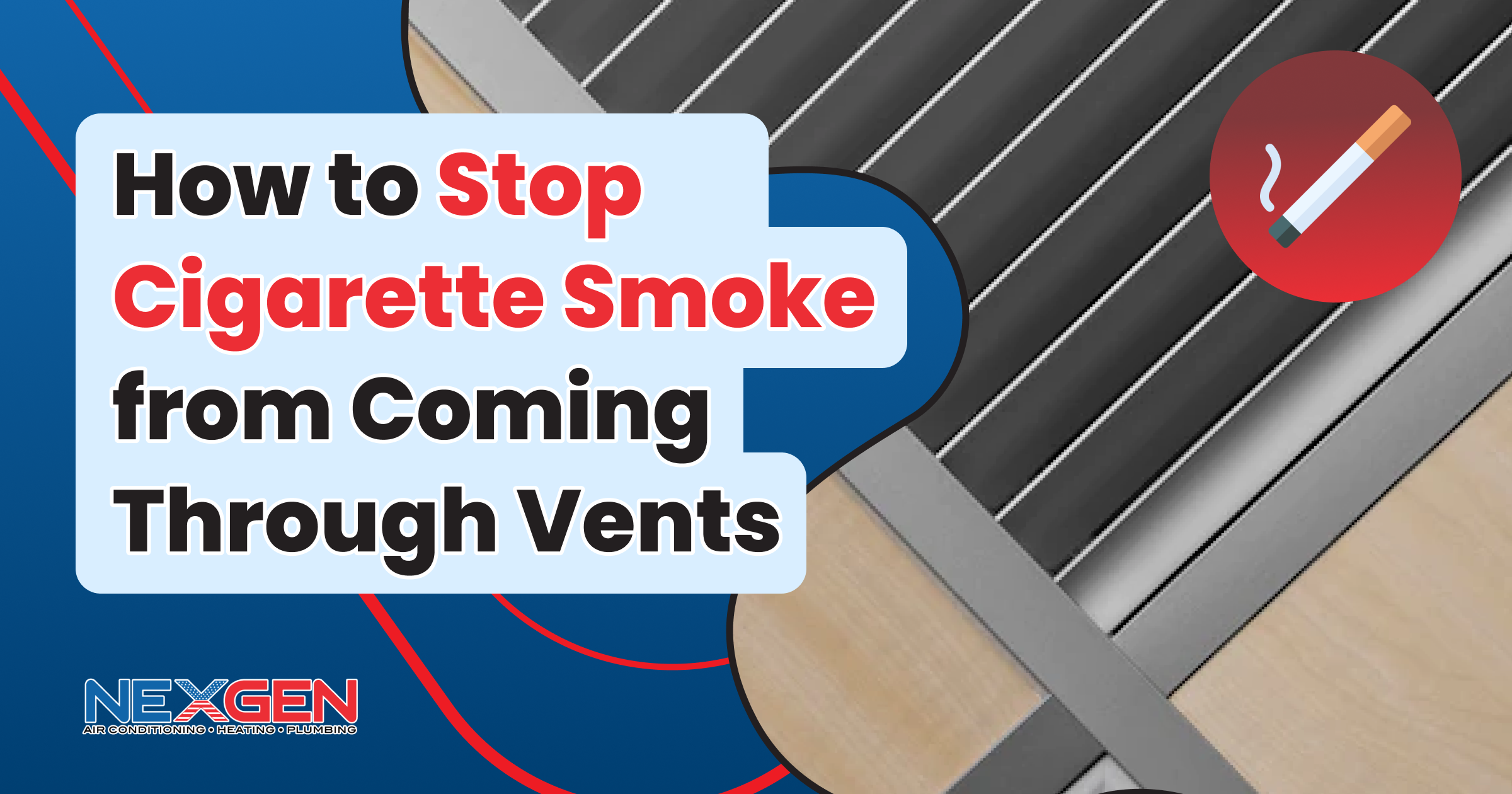How to Block Smoke from Coming Through AC Vents

At NexGen, we understand the importance of good indoor air quality. Smoke is one of the most significant indoor pollutants. There are numerous potential sources, but perhaps none are as prevalent and potentially dangerous as cigarette smoke. Secondhand smoke contains over 7,000 chemicals, hundreds of which are toxic. Even if you or no one in your family uses tobacco, smoke entering your home through vents can be extremely harmful.
Here, we’ll explain how to block smoke from coming through the vents in your home to eliminate exposure and its risks.
Regarding exposure to secondhand smoke, the U.S. Surgeon General issued a report in 2006 that concluded:
- Conventional air filtration systems remove larger particles, but not the smaller particles and gases from cigarette smoke.
- An enclosed, individually exhausted, negative-pressure room won’t prevent smoke from traveling into adjacent spaces.
- Standard HVAC systems by themselves don’t control secondhand smoke exposure and may help distribute smoke particles and gases.
Modifying Your Vents to Block Smoke
The first step is to locate where secondhand smoke is entering from. Air vents are one of the primary entry points. Others include gaps in windows, doors, outlets, insulation, etc. While small gaps can be filled with silicone caulk and larger ones with insulating foam, that doesn’t work with vents. You can’t completely block a vent because that will disrupt airflow, reduce efficiency, and increase the pressure that may damage ducts and cause leaks.
This is an issue because once cigarette smoke enters the system, it will travel through ductwork and come through vents in every room. Fortunately, other options can protect your home against secondhand smoke. These are some steps you can take:
Install a HEPA Filter
A high-efficiency particulate air (HEPA) filter has a fine mesh that makes it more effective at trapping tobacco smoke as well as pollen, pet dander, and dust mites. Therefore, this mechanical air filter protects against the harmful effects of smoke and can provide allergy relief. It can improve overall indoor air quality and protect your HVAC system against particulates as well.
Use a Door Draft Excluder
Smoke and odors may pass through from under any door that opens into a hallway or common area. A door draft excluder easily fits along the bottom of the door. Draft proofing can be accomplished with stuffed plastic bags or by purchasing and fitting a hinged flap or brush-type draft excluder. You can also purchase covers that drop over keyholes and flaps or brushes that cover letterboxes.
Install an Air Purifier
A high-quality air purifier is a worthwhile investment. Your HVAC contractor can recommend and even install an air purification system. The best ones eliminate visible smoke and odors. While it may be difficult to block smoke from vents, the air can still be purified so you don’t have to worry about breathing in tobacco smoke.
Get House Plants
Bamboo palm, peace lily, philodendron, devil’s ivy, aloe vera, azalea, and chrysanthemum are just a few plants that can remove contaminants from the air. These natural air filters will leave your indoor air fresher. Not to mention create a calming environment in your house.
Open Windows
This is not a permanent solution. If the outdoor air isn’t polluted and it’s a pleasant day, you can open windows to allow in a fresh breeze and filter out stagnant, smoke-filled air. This works best when the AC isn’t running. However, consider other solutions if there’s a lot of car traffic outside your home; you don’t want exhaust on top of tobacco smoke indoors.
Let NexGen See How to Block Smoke from Coming Through AC Vents
NexGen provides many solutions to address indoor air quality issues. We can install high-efficiency filtration systems, improve ventilation, and clean ductwork as well as find custom solutions to improve air quality in your home. Our technicians are fully licensed and trained and provide service throughout Southern California. In addition, our products are warrantied for up to 12 years and financing options are available to make much-needed solutions affordable.
To get started, book service online or call us at 833-729-9735.
How to Stop Cigarette Smoke from Coming Through Vents

Air ducts and vents can distribute secondhand smoke throughout a home and from one apartment to another in a building. Cigarette smoke is associated with many health problems, including lung cancer. It may produce an odor and leave behind yellow stains on walls and brownish residue on curtains and drapes. No matter how much deodorizer your spray or vacuuming and cleaning you do, it won’t reach everywhere. Continue reading to learn how to stop cigarette smoke from coming through vents in the first place.
Clean the Vents
To start, it helps to clean the nicotine residue off vents. You’ll need to remove each vent from its fitting and place it in a well-ventilated area. Choose your cleaning solution; mild dish soap will often do (if using a chemical cleaner, wear gloves and safety goggles). Avoid abrasive tools; instead, use a soft cloth or sponge to wipe down the vent. You can clean the slats with a narrow soft brush.
Install a Charcoal Register Vent Filter
Filters with activated charcoal are designed to fit inside vents. Depending on the product, it can trap dirt, dust, and pollen as well as prevent objects from falling into air ducts. One type of vent filter uses a self-charging electrostatic material to attract pollutants. Smoke and other particles become trapped and only filtered, smoke-free air enters your home.
Seal Vent Gaps with Insulation Padding and Painter’s Tape
Cigarette smoke can also drift in through gaps around air vents, air conditioners, and heaters. This smoke often bypasses any filters. To use insulation padding, tuck it into any gaps and lay it over the surrounding surface; then secure it with painter’s tape. Placing padding and tape isn’t an infrastructure change so won’t violate your lease agreement. But first, talk to your landlord to see if they have a better way to seal gaps.
Have Your Air Ducts Cleaned Professionally
Cigarette smoke is most likely not limited to the vent surface. The chemicals in cigarette smoke can reach remote areas of air ducts. Air duct cleaning helps whether you have a persistent smoke problem, are a smoker, or moving into a home where there were smokers. An HVAC professional is equipped with equipment and cleaning products that can reach where other solutions can’t and effectively break down smoke molecules.
How to Eliminate Cigarette Smoke Odors
Various types of cleaners can work. But you don’t have to use a chemical cleaner. You can wipe the vent down with plain vinegar or a mix of 1 tablespoon of ammonia in 1 cup of water. If this doesn’t work, mix 1 part bleach into 4 parts warm water and soak the vent for a few hours before rinsing it. Let the vent cover dry and reinstall it.
Blocking Smoke from Other Sources
Knowing how to stop cigarette smoke from coming through vents won’t always eliminate a smoke problem. Consider other sources as well, and take action to prevent smoke from continuing to get in. Here are some solutions:
- Caulk or tape over cracks around windows, doors, and lighting fixtures.
- Cover electrical sockets with plugs or seals.
- Place a fan near an open window when you see or smell smoke.
- Apply weatherstripping to windows to block outdoor smoke.
- Use a door sweep or draft guard to block smoke from outside.
Contact NexGen for Indoor Air Quality Solutions
NexGen can address air quality issues with a range of options. If cigarette smoke, mold, volatile organic compounds, carbon monoxide, or other pollutants are found in your home, we will help make air quality improvements. Air purification and filtration systems can be installed or we can help improve ventilation (duct cleaning, installing dehumidifiers, and furnace repair can help as well).
To learn more about our indoor air quality services in Southern California and request service, call 833-729-9735 today.
Does a Window AC Take Air from Outside?

It’s a common belief that window ACs bring fresh air into your home from the outside. We’re here to tell you—that’s not true. Instead, a window air conditioner normally pulls air into it via a fan, cools and filters it, and then recirculates that air back into the building. For those who ask, “Does a window AC take air from outside?”, we’ll now provide a more detailed explanation of how it works.
How a Refrigerated Air Conditioner Works
An evaporative unit will pull outside air into a building. This air is first drawn through water-soaked pads to cool it. But that’s not what a refrigerated AC, the most common type, does. It blows air across a coil, through which refrigerant flows; the temperature of the air falls as it passes through the system. Heat is absorbed in the process.
A window AC features ventilation grates on the side. These may seem positioned to draw in outside air. However, they only allow air into the condenser coil to help cool the machine so it doesn’t overheat. Meanwhile, hot air is exhausted through the rear vents.
A Window AC Is a Sealed System
Window air conditioners are sealed, so therefore won’t pollute the air they cool. People may find that if there’s smoke pollution outside, it tends to get indoors. It’s not coming through the AC but rather through open windows, cracks in doors, or small openings in walls and even a unit that might need to be repaired or replaced.
If you find the AC filter becomes dirty more quickly, this same process may be in play. The filter captures particles from indoor air drawn into the unit, so it can recirculate clean air. Without a filter, or if the filter is clogged, particles can damage the unit. A clogged filter can also restrict airflow and cause the AC to strain and work harder to provide cool air.
The Same Goes for All Window ACs
Most window AC units are standalone box-shaped machines. These fit onto the window sill and are easy to install. The challenge is to create an effective seal around the unit, so air cannot get in or out through any gaps. Otherwise, the unit will work harder and you’ll have to pay for using more electricity.
Window ACs use only the air from your home to provide cooling. So do portable split system AC units. These have a tower-style AC unit and an exhaust hose that pushes out warm air via a window fitting. Newer models are often quieter, offer better filtration, and include smart controls.
Fresh vs. Filtered Air: When Does a Window AC Take Air from Outside?
The air you normally feel blowing from a window AC is filtered to remove any pollutants and particles. But the unit won’t remove carbon dioxide, carbon monoxide, and other gasses or microscopic particles that make up, for example, smoke. Fresh air differs from the filtered air in that it originates outside your home.
You may be wondering why you’d want to let air in using a system designed to prevent that. That’s what the vent lever on your window AC is for. If the air in your home is stale, smoky, dirty, or smelly, bringing fresh air in can help clear out the pollution. Opening the vent can also provide efficient cooling if the air is cooler outside than inside.
So, yes, a window AC can take air from outside, but only if you want it to.
Contact NexGen
At NexGen, we install all types of air conditioning systems in Los Angeles and Southern California. While our licensed technicians are experienced with high-efficiency central and ductless mini-split units, they can install window units as well. These are low-cost, efficient, and easy-to-install HVAC appliances that provide cooling, filtration, and dehumidification. To schedule service by a licensed, insured technician, call 833-729-9735 today.











